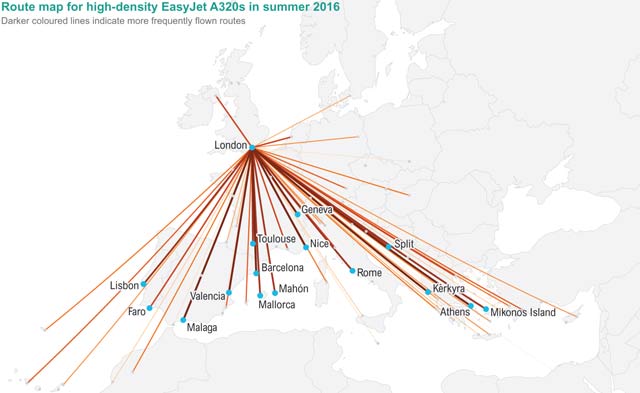Airbus unveiled its Space-Flex lavatory and galley concept for the A320 at the Aircraft Interiors Expo in 2011. The design replaced a full-width rear galley with a smaller galley and toilet combination, freeing up room for extra legroom or an extra row of seats.
Space-Flex has gained traction since the European Aviation Safety Agency re-evaluated the narrowbody, allowing Airbus to increase the exit limit on the type from 180 to a potential 195 seats. According to Airbus, 70% of low-carriers and charter operators have since chosen Space-Flex.
Get all the coverage from Aircraft Interiors Expo on our dedicated landing page
The initial Space-Flex version entered service in 2013 with LATAM Airlines Group. The idea has since evolved to its current form, which offers increased galley capacity – important when dealing with higher-density configurations. This change was made by Airbus in collaboration with airline customers.
Airbus offers Space-Flex as a line fit option as well as supplying it as a kit which can be retrofitted on carriers’ existing A320 fleets. The concept is part of an effort by Airbus to develop a cabin branding called AirSpace. It will feature across the A320 family as well as on widebodies like the A350 and A330neo.
According to Flight Fleets Analyzer there are currently 112 in-service A320s with more than 180 passenger seats, up to a maximum of 188. European low-cost carrier Vueling was the first carrier to take advantage of the A320’s increased exit limit when MSN6483 was delivered in March 2015, and has adding a further 15 186-seat A320s since.
In North America, Spirit Airlines was the first carrier to feature the Space-Flex cabin option. Its A320s contain 182 seats, eight of which are marketed as business class with a 36in pitch and a width of 18.5in.
Boeing’s selection of upward- and outward-swinging overwing emergency doors on its narrowbodies has long meant its exit limit was greater than that found on comparable Airbus types: there are 1,373 in-service 737-800s with more than 180 seats, 79% of which can accommodate 189 passengers or more.
Boeing’s 737 Max family – the more fuel-efficient next generation of its narrowbody – includes a 737 Max 200.
This high-density variant is based on the 737 Max 8 but features a reconfigured exit row arrangement, allowing it to accommodate up to 200 passengers in a one-class configuration. Ryanair is set to be the launch customer for the Max 200, with first delivery expected in 2019. It has ordered 100 of the variant with another 100 options.

Vietnamese low-cost carrier VietJet Air is also on Boeing’s books for the Max 200 with 100 orders, while the Chinese mainline Xiamen Airlines signed a memorandum of understanding for up to 30 examples for its low-cost operations at the Farnborough air show in July 2016.
CASE STUDY: EASYJET
With more than 200 Airbus A320-family jets in service, EasyJet is one of the world’s largest operators of the Toulouse-made narrowbody.
On top of receiving higher-density A320s direct from the manufacturer, EasyJet is putting 105 of its existing fleet through a retrofit programme over the next year, spreading the work between Slovenian MRO provider Adria Tehnika, Iberia Maintenance, SR Technics and Lufthansa Technik.
The work will feature the reconfiguration of the aft cabin to the Space-Flex format, with the majority of each retrofit kit being supplied by Airbus, allowing an extra row of seats to be installed and bringing total passenger capacity to 186 in an all-economy configuration.
The additional space made available by reshuffling the galley and lavatory position means average and minimum seat pitch on board remains the same as on EasyJet’s lower-capacity twinjets. Recaro’s non-reclining SL 3510 seats have been chosen; they have a 17.1in width and are installed with a pitch of 29.9in.
EasyJet received its first line-fitted Space-Flex A320 in May 2016 as part of a set of seven over the summer period.

Use of flight tracking data from FlightGlobal’s FlightStats tracking data service allows routes flown by EasyJet’s 186-seat aircraft to be discerned.
During the 2016 summer season – 27 March to 29 October – 4,159 EasyJet flights were flown by these seven aircraft on 74 distinct airport pairs.
The aircraft entered into service between May and July, in general each flying four or six segments a day.
Based at London Gatwick over this period, the aircraft tended to fly to popular tourist destinations in southern Europe, with the top 15 routes shown here accounting for around 71% of flights seen.
Indicators suggest that higher-density cabins were not simply added to EasyJet’s schedule and deployed randomly. This is borne out by the top routes flown by this sub-fleet not directly matching the top scheduled routes flown by the low-cost carrier over the period.
EasyJet’s schedule contained on average fewer than 12 round-trips per week from Gatwick to Athens, Corfu, Lisbon, Split and Mahón during summer 2016 – compared with about 40 for the likes of Geneva and Barcelona.
EasyJet also appeared to move around the deployment of its high-density jets during the season. Around the middle of September, the sub-fleet stopped visiting Valencia and Pisa as often, while destinations including Tenerife, Thessaloniki and Dalaman received more visits from the 186-seaters.
Get all the coverage from Aircraft Interiors Expo on our dedicated landing page
Source: Flight Daily News



















